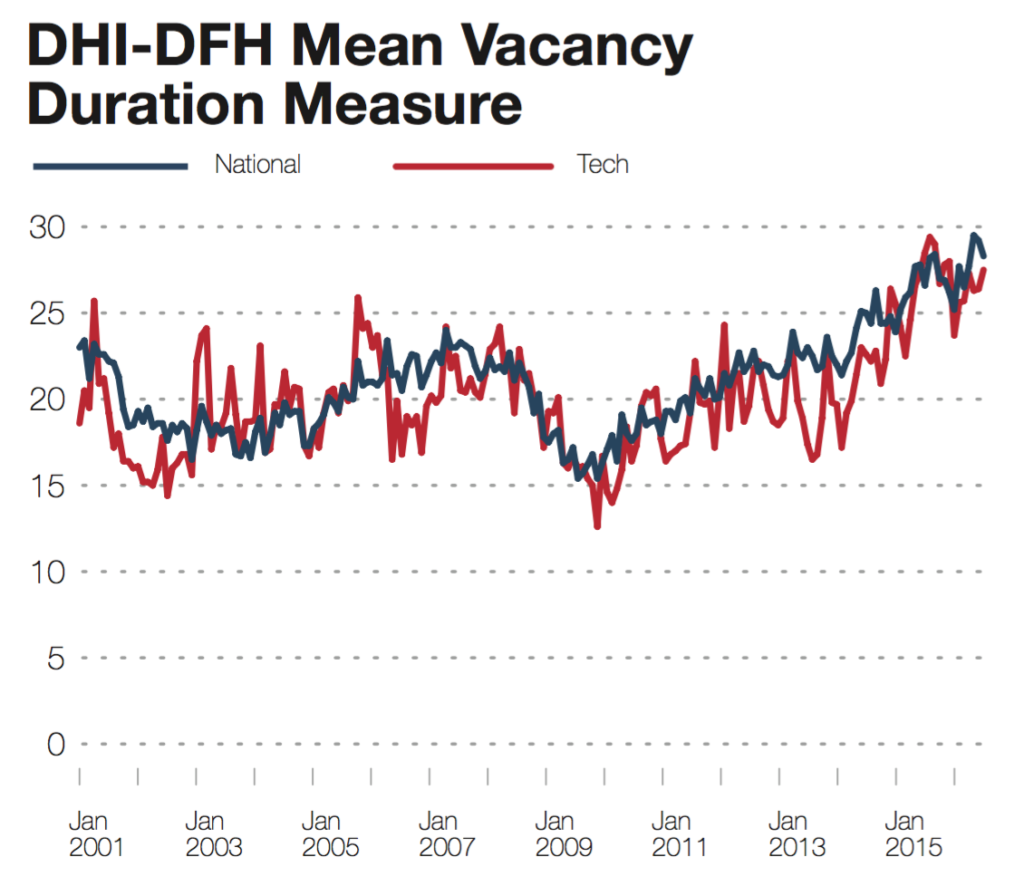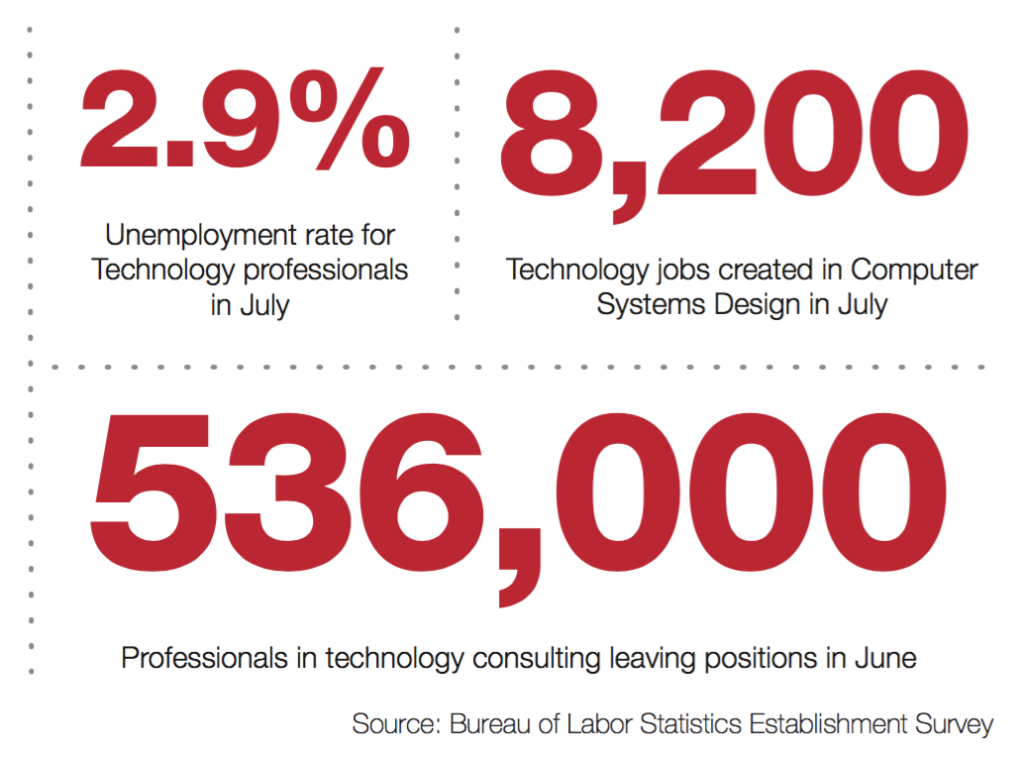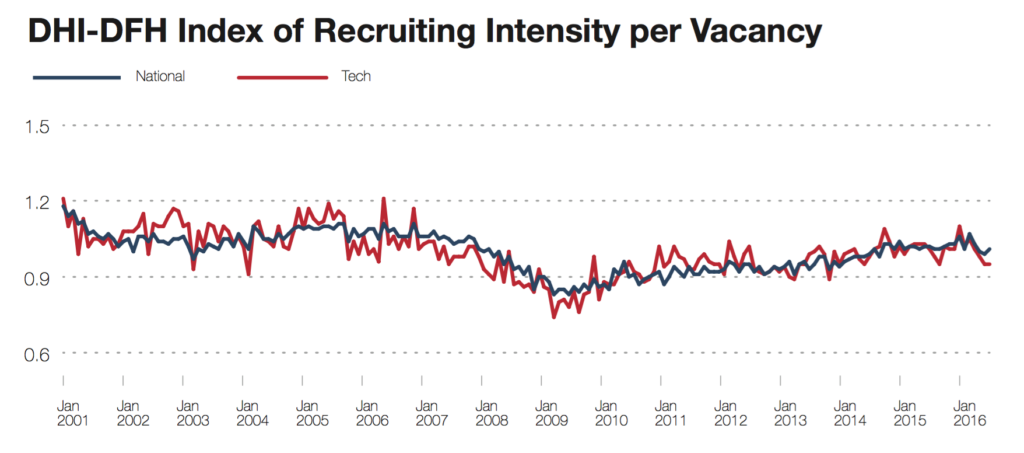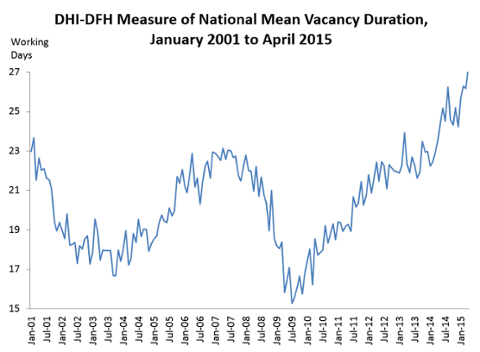
The DHI-DFH Mean Vacancy Duration measure found the average job vacancy duration of Professional and Business Services jobs to be 26.5 working days in 2016. In June, technology jobs remained open for 27.5 working days, up from a revised 26.4 days in May. This is slightly below the national average of 28.3 working days. The DHI-DFH Vacancy Duration measure reflects the vacancy concept in the Job Openings and Labor Turnover Survey (JOLTS) in the United States. Specifically, a job opening gets “filled” according to JOLTS when a job offer for the open position is accepted. So the vacancy duration statistics refer to the average length of time required to fill open positions. Typically, there is also a lag between the fill date and the new hire’s start date on the new job.

“As hiring managers search to find talent with specialized skills and candidates consider all available options before choosing a new employer, the time to fill positions remains highly elevated, potentially slowing work and progress at companies,” said Michael Durney, President and CEO of DHI. “Wise employers leverage both traditional and non-traditional products, like sourcing services and talent CRMs, to expedite the recruiting process and find qualified talent more quickly and efficiently.” Meanwhile, the DHI-DFH Recruiting Intensity index saw the intensity of companies to fill tech jobs remain unchanged at 0.95 in June:

This recruiting intensity includes actions by employers to fill a job, including payments on help wanted ads, certain recruiting methods, applicant screening process, hiring standards and the attractiveness of compensation packages offered to prospective new hires. “In today’s competitive tech market, employers continue to find attracting and hiring qualified tech talent difficult,” said Bob Melk, President of Dice. “Employers are considering alternative recruitment methods like a heavier reliance on sourcing, in conjunction
with traditional ones, to offset hiring challenges. Building a talent pipeline early allows employers to have a pool of qualified candidates on reserve for when a new position becomes available.” The DHI Hiring Indicators offer labor market insights from DHI and Dr. Steven Davis, William H. Abbott Professor of International Business and Economics at the University Of Chicago Booth School Of Business and a Visiting Fellow at the Hoover Institution.
 The DHI-DFH Mean Vacancy Duration measure found the average job vacancy duration of Professional and Business Services jobs to be 26.5 working days in 2016. In June, technology jobs remained open for 27.5 working days, up from a revised 26.4 days in May. This is slightly below the national average of 28.3 working days. The DHI-DFH Vacancy Duration measure reflects the vacancy concept in the Job Openings and Labor Turnover Survey (JOLTS) in the United States. Specifically, a job opening gets “filled” according to JOLTS when a job offer for the open position is accepted. So the vacancy duration statistics refer to the average length of time required to fill open positions. Typically, there is also a lag between the fill date and the new hire’s start date on the new job.
The DHI-DFH Mean Vacancy Duration measure found the average job vacancy duration of Professional and Business Services jobs to be 26.5 working days in 2016. In June, technology jobs remained open for 27.5 working days, up from a revised 26.4 days in May. This is slightly below the national average of 28.3 working days. The DHI-DFH Vacancy Duration measure reflects the vacancy concept in the Job Openings and Labor Turnover Survey (JOLTS) in the United States. Specifically, a job opening gets “filled” according to JOLTS when a job offer for the open position is accepted. So the vacancy duration statistics refer to the average length of time required to fill open positions. Typically, there is also a lag between the fill date and the new hire’s start date on the new job.  “As hiring managers search to find talent with specialized skills and candidates consider all available options before choosing a new employer, the time to fill positions remains highly elevated, potentially slowing work and progress at companies,” said Michael Durney, President and CEO of DHI. “Wise employers leverage both traditional and non-traditional products, like sourcing services and talent CRMs, to expedite the recruiting process and find qualified talent more quickly and efficiently.” Meanwhile, the DHI-DFH Recruiting Intensity index saw the intensity of companies to fill tech jobs remain unchanged at 0.95 in June:
“As hiring managers search to find talent with specialized skills and candidates consider all available options before choosing a new employer, the time to fill positions remains highly elevated, potentially slowing work and progress at companies,” said Michael Durney, President and CEO of DHI. “Wise employers leverage both traditional and non-traditional products, like sourcing services and talent CRMs, to expedite the recruiting process and find qualified talent more quickly and efficiently.” Meanwhile, the DHI-DFH Recruiting Intensity index saw the intensity of companies to fill tech jobs remain unchanged at 0.95 in June:  This recruiting intensity includes actions by employers to fill a job, including payments on help wanted ads, certain recruiting methods, applicant screening process, hiring standards and the attractiveness of compensation packages offered to prospective new hires. “In today’s competitive tech market, employers continue to find attracting and hiring qualified tech talent difficult,” said Bob Melk, President of Dice. “Employers are considering alternative recruitment methods like a heavier reliance on sourcing, in conjunction with traditional ones, to offset hiring challenges. Building a talent pipeline early allows employers to have a pool of qualified candidates on reserve for when a new position becomes available.” The DHI Hiring Indicators offer labor market insights from DHI and Dr. Steven Davis, William H. Abbott Professor of International Business and Economics at the University Of Chicago Booth School Of Business and a Visiting Fellow at the Hoover Institution.
This recruiting intensity includes actions by employers to fill a job, including payments on help wanted ads, certain recruiting methods, applicant screening process, hiring standards and the attractiveness of compensation packages offered to prospective new hires. “In today’s competitive tech market, employers continue to find attracting and hiring qualified tech talent difficult,” said Bob Melk, President of Dice. “Employers are considering alternative recruitment methods like a heavier reliance on sourcing, in conjunction with traditional ones, to offset hiring challenges. Building a talent pipeline early allows employers to have a pool of qualified candidates on reserve for when a new position becomes available.” The DHI Hiring Indicators offer labor market insights from DHI and Dr. Steven Davis, William H. Abbott Professor of International Business and Economics at the University Of Chicago Booth School Of Business and a Visiting Fellow at the Hoover Institution.



